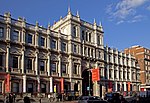Burlington Arcade

Burlington Arcade is a covered shopping arcade in London, England, United Kingdom. It is 196 yards (179 m) long, parallel to and east of Bond Street from Piccadilly through to Burlington Gardens. It is one of the precursors of the mid-19th-century European shopping gallery and the modern shopping mall. It is near the similar Piccadilly Arcade. The arcade was built in 1818 to the order of George Cavendish, 1st Earl of Burlington, younger brother of William Cavendish, 5th Duke of Devonshire, who had inherited the adjacent Burlington House, on what had been the side garden of the house and was reputedly to prevent passers-by throwing oyster shells and other rubbish over the wall of his home. It was designed by architect Samuel Ware. Burlington Arcade was built "for the sale of jewellery and fancy articles of fashionable demand, for the gratification of the public". However, it was also said to have been built so that the Lord's wife could shop safely amongst other genteel ladies and gentleman away from the busy, dirty, and crime-ridden open streets of London.Burlington Arcade opened on 20 March 1819. From the outset, it positioned itself as an elegant and exclusive upmarket shopping venue, with shops offering luxury goods. It was one of London's earliest covered shopping arcades and one of several such arcades constructed in Western Europe in the early 19th century. (Other examples of grand shopping arcades include: Covered passages of Paris, Palais Royal in Paris (opened in 1784); Passage de Feydeau in Paris (opened in 1791), Galeries Royales Saint-Hubert in Brussels and The Passage in St. Petersburg, the Galleria Umberto I in Naples, and the Galleria Vittorio Emanuele II in Milan (1878).) The original arcade consisted of a single straight top-lit walkway lined with 72 small two-storey units. Some of the units have been combined, reducing the number of shops to around 40. The Piccadilly façade, with sculptures carved by Benjamin Clemens, a professor of sculpture at the Royal College of Art, was added in 1911. The arcade is patrolled by beadles in traditional uniforms that include top hats and frock coats. The original beadles were all former members of Lord George Cavendish's regiment, the 10th Royal Hussars. The arcade maintains Regency decorum by banning singing, humming, hurrying, and "behaving boisterously".The present tenants include a range of clothing, footwear and accessory shops, art and antique dealers, and the jewellers and dealers in antique silver for which the Arcade is best known.
Excerpt from the Wikipedia article Burlington Arcade (License: CC BY-SA 3.0, Authors, Images).Burlington Arcade
Old Bond Street, City of Westminster Mayfair
Geographical coordinates (GPS) Address Nearby Places Show on map
Geographical coordinates (GPS)
| Latitude | Longitude |
|---|---|
| N 51.509 ° | E -0.1403 ° |
Address
Old Bond Street 14
W1S 4PP City of Westminster, Mayfair
England, United Kingdom
Open on Google Maps









